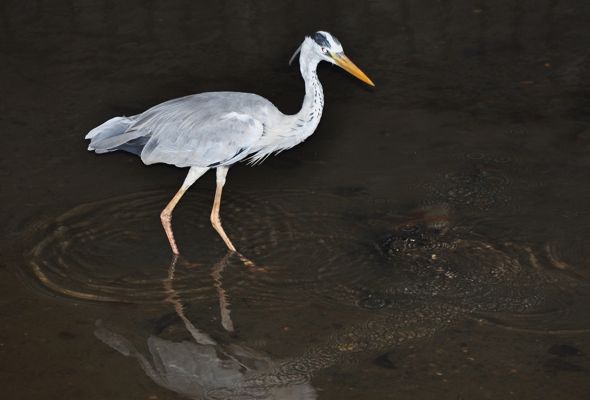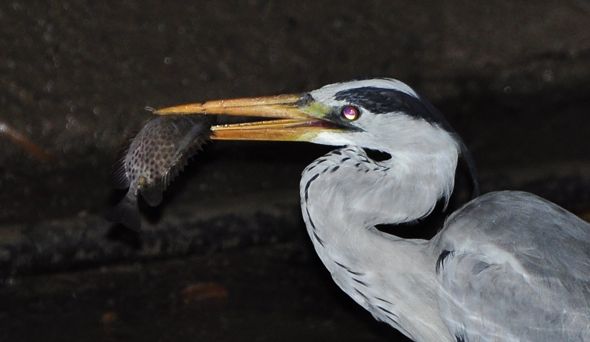“On the night of 16th January 2012, I was strolling along the canal nearby my home to monitor the resident Black-crowned Night Herons (Nycticorax nycticorax), when a lanky, ghostly figure with long legs and long neck appeared in front of my eyes. With mixed feelings of disbelief and excitement, I soon realised that this was in fact an adult Grey Heron (Ardea cinerea) that had just appeared on the night scene. The Grey Heron appeared to be a little wary and nervous, as it slowly paced up and down a short stretch of the canal. That night, however, it did not make any attempts to catch fish, but flew away after a brief five-minute reconnaissance.
“Subsequently, on the night of 28th January 2012, the Grey Heron returned, scouting the waters with less hesitation and more confidence this time. It waded within close range of the Black-crowned Night Herons, which were seemingly unperturbed by this giraffe-like bird towering over them (above). When the Grey Heron detected movements in the water, it would gravitate towards the fish schools and make repeated attempts at striking (below).
“Witnessing the Grey Heron in action made me realise the overwhelming hunting advantages it had over the Black-crowned Night Heron. Firstly, its long legs allowed it to venture into deeper waters that may be beyond the comfort zone for the Night Heron. Second, its long neck and bill translates to a much further reach when fully extended, far surpassing that of the Night Heron’s. However, in terms of night vision, I believe the Grey Heron still cannot hold a candle to the Night Heron.
“That night, the Grey Heron actually succeeded in spearing and swallowing two Gold-blotched Rabbitfish (Siganus guttatus, family Siganidae) (above). It seems that this particular fish species was fresh on the dinner menu, as the Night Heron was also eagerly wolfing it down (image 4, below). Previously, a solitary Grey Heron had been observed along the Bedok Canal (also in the East) by Timothy Pwee (blog posted on 14th November 2005). I wonder if other bird watchers have likewise seen such nocturnal fishing activity by Grey Herons in Singapore, or anywhere else in its broad geographic range. Their eye-witness accounts from their respective regions would be most welcome. Other herons (family Ardeidae) that have been known to feed at night include the Great Blue Heron (Ardea herodias) and Pacific Reef Egret (Egretta sacra) in tidal environments (Watmough, 1978).”
Leong Tzi Ming
Singapore
2nd February 2012
Acknowledgement:
Thanks to Kelvin K. P. Lim (Raffles Museum of Biodiversity Research) for kindly confirming the identity of the fish prey.
Reference:
Watmough, B. R., 1978. Observations on nocturnal feeding by night herons Nycticorax nycticorax. Ibis, 120(3): 356–358.













3 Responses
Fantastic that the herons can swallow Siganus of the size shown in the photograph. These fish have formidable spines in their dorsal and anal fins. The bird has to ensure that the fish can be successfully swallowed, because there is no way the meal can be regurgitated if the bird decides that it has bitten off more than it can cope with.
Interesting. I fed my goldfish and koi on the evening of June 13. All (20-25) showed up for mealtime. The next morning, I saw only 1 large and maybe 1 small at breakfast time. I had just added additional dye 2 days’ prior due to 100 degree temps and direct sun for part of the day. I wonder if the moon was full. I’ll be interested to find out if that part is true here in north Texas also!
Two weeks prior, I kept finding fish in my pump housing. Now, I wonder if they were seeking safety from a heron. I blocked their way into the housing to keep them safe! Oh, no!